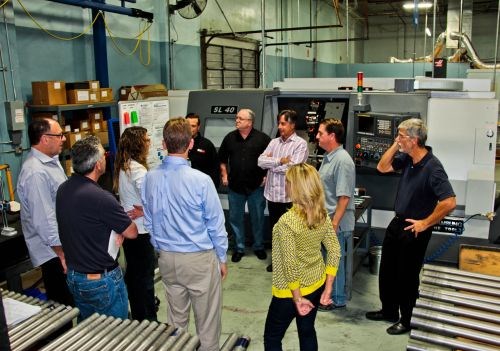Collaborating with Competitors
Shops willing to work with their competition to solve common problems and avoid making the same mistakes could potentially improve not only their own operations, but U.S. manufacturing as a whole.

The Southern California Manufacturing Group gathers to discuss one member's new machine.
“There’s plenty of work to go around.” These words were uttered by two different people, whom I interviewed for two different articles, in response to a question about why the benefits of working together with competing shops outweigh the potential risks. Both sources also agree that collaborating to solve common problems and avoid making the same mistakes could help ensure that U.S. manufacturers continue to enjoy “plenty of work to go around” in the future. However, their respective organizations represent very different models for this collaboration.
One of those sources, Shaun Karn of Hi-Tech Mold & Engineering, serves as co-chair of the Original Equipment Supplier Association (OESA) Tooling Forum, which is profiled in MoldMaking Technology’s January issue. Conceived in September 2012, the forum aims to provide independent automotive tool vendors with a collective voice as well as a means to discuss common problems and share best practices. Representatives from 25 member shops meet monthly to explore such topics as PPAP payment terms, workforce development, supplier audits, benchmarking and more. Beyond the catharsis that comes with discussing what keeps everyone up at night, the group offers concrete deliverables that can provide real market intelligence and insights that could potentially impact the bottom line (among the most notable of these deliverables is the 2013 Vendor Tooling Study). Click here to learn more.
The second source is S&H Machine’s David Fisher, who founded a tighter-knit group that takes collaboration even further. The Southern California Manufacturing Group (SCMG) consists of seven Los Angeles-area shops that share even the most intimate details of their operations. That’s a significant difference from the OESA Tooling Forum, which tends to keep discussions to broader, strategic level topics. Another distinction is that the SCMG consists solely of shops that specialize in machining aerospace components (I wrote about the SCMG for our sister publication, Modern Machine Shop, before transferring to MoldMaking Technology a few months ago). Nonetheless, Mr. Fisher’s stated hope is that other shops in other industries will form their own peer groups to ensure the United States maintains a stable community of competitive manufacturers, and I see no reason why moldmakers couldn’t follow the SCMG’s model.
Click here to learn more about what makes the group tick. I'm also curious about your thoughts—specifically, whether you'd consider something like this and what you view as the potential risks and benefits of collaborating with competitors. Just send me an email.
Related Content
-
2021 30 Under 30 Honors Program: Mentoring in the Next-Generation of Moldmaking Professionals
Young professionals are vital to the moldmaking industry, and it is important to acknowledge those making strides in shaping the industry's future. MoldMaking Technology recognizes the industry's young talent through its 30 Under 30 Honors Program.
-
MMT Chats: Marketing’s Impact on Mold Manufacturing
Kelly Kasner, Director of Sales and Marketing for Michiana Global Mold (MGM) talks about the benefits her marketing and advertising, MGM’s China partnership and the next-generation skills gap. This episode is brought to you by ISCAR with New Ideas for Machining Intelligently.
-
Leading Mold Manufacturers Share Best Practices for Improving Efficiency
Precise Tooling Solutions, X-Cell Tool and Mold, M&M Tool and Mold, Ameritech Die & Mold, and Cavalier Tool & Manufacturing, sit down for a fast-paced Q&A focused on strategies for improving efficiencies across their operations.
_970x90 3.png;maxWidth=970;quality=90)











.jpg;maxWidth=300;quality=90)
.jpg;maxWidth=970;quality=90)